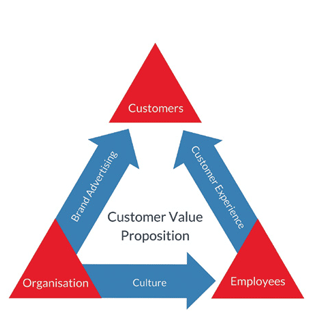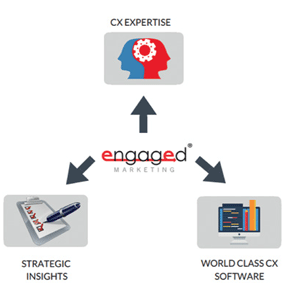THANK YOU FOR SUBSCRIBING

Engaged Marketing: CX Programs Require a Holistic Approach to Succeed

 Christopher Roberts, MD
Christopher Roberts, MDImplementing a successful CX program is not easy. A recent study indicated that a staggering 81 per cent of organisations have seen their Customer Experience Management (CXM) initiatives fail in the last three years.
To manage this risk, strategic consulting firm Engaged Marketing recommends a holistic CX view. Their proprietary Total Engagement Model® (TEM) helps companies align who they are (culture), what they do (customer experience) and what they say (brand communication) based on their uniquely defined customer value proposition.
Christopher Roberts, the Managing Director of Engaged Marketing, explains the rationale behind their consultancy model. “Too often promises made in advertising are not met with actual customer experiences. Consistently good or bad customer experiences are a direct reflection of the internal culture."
 Figure 1.0 Total Engagement Model
Figure 1.0 Total Engagement ModelCustomer sentiment is critical. “The secret of great experiences is how you make your customers feel emotionally. Because this is typically delivered by staff, a key point to remember is that you can automate many things but if a staff member does not feel valued and cared for, they cannot make customers feel valued and cared for. The positive emotional transference from employees to customers is the ultimate secret of loyalty leaders,” Mr Roberts explains.
Engaged Marketing’s Total Engagement Model® ensures the alignment of both internal and external experiences together with external messaging.”
A successful CX program requires people, process and system strategies working in harmony. Typically, CX firms focus on either market research, software solutions, or consultancy in isolation. In comparison, Engaged Marketing offers an end-to-end service from developing your customer strategic intentions, to collecting customer insights via sophisticated surveys, turning these insights into actionable recommendations and helping organisations with embedding regular disciplines.

Figure 2.0 Engaged Marketing’s Holistic Approach
Engaged Marketing clients who have applied the Total Engagement Model® and developed their CX program utilising a holistic approach enjoy record improvements in their CX experience and Net Promoter® Scores (NPS®), a leading customer experience measure linked to organisational growth.
“There is no doubt that our contemporary methodologies, leading software solutions, end-to-end services, local expert knowledge - our holistic approach - are our main strengths to help our clients develop customer experiences worthy of recommendation and contribute to their ongoing success. Our clients which applied TEM principles have enjoyed NPS® increases of up to 50 points,” says Mr. Roberts.
Their experience and knowledge in Australia and New Zealand is extensive thanks to the many Consumer Benchmarking and National Employee Engagement studies they have conducted over the last 9 years. They have accumulated insight and expertise from more than 165 different brands, across 20 plus industries in the Asia-Pacific region.
Engaged Marketing’s main methodology and metric for customer and employee experience services is NPS®. They are the official distributor for Satmetrix NPX in the Asia Pacific region, the world’s leading CX software developed by the co-creator of the Net Promoter® Score discipline.
“NPS® is used by approximately 65 per cent of the top 200 companies in the world. There are three main reasons we utilise NPS®. Firstly, it’s a higher order measure than mere satisfaction because it measures recommendation and loyalty. Secondly, it’s linkages to organisations’ financials have been proven independently. Finally, NPS® perfectly fits into our proprietary Total Engagement Model®,” adds Mr. Roberts
Engaged Marketing is keenly aware of the evolving playing field that is customer experience incorporating Design Thinking, a people-centred approach to innovation, and sophisticated change management principles into the services they offer. Their focus on Digital Transformation will give their clients the required tools and skillsets to proactively strategise and defend against digital disruptors.
Engaged Marketing is committed to their clients’ success. “Our singular objective is to unleash potential within organisations and individuals. We constantly work on new models and methodologies to help our clients develop and manage the best CX program” says Mr. Roberts.
Engaged Marketing currently has offices in Australia and India and with clients around the world the company is looking to open an office in the USA in the near future.
A successful CX program requires people, process and system strategies working in harmony. Typically, CX firms focus on either market research, software solutions, or consultancy in isolation. In comparison, Engaged Marketing offers an end-to-end service from developing your customer strategic intentions, to collecting customer insights via sophisticated surveys, turning these insights into actionable recommendations and helping organisations with embedding regular disciplines.

Figure 2.0 Engaged Marketing’s Holistic Approach
Engaged Marketing clients who have applied the Total Engagement Model® and developed their CX program utilising a holistic approach enjoy record improvements in their CX experience and Net Promoter® Scores (NPS®), a leading customer experience measure linked to organisational growth.
“There is no doubt that our contemporary methodologies, leading software solutions, end-to-end services, local expert knowledge - our holistic approach - are our main strengths to help our clients develop customer experiences worthy of recommendation and contribute to their ongoing success. Our clients which applied TEM principles have enjoyed NPS® increases of up to 50 points,” says Mr. Roberts.
Their experience and knowledge in Australia and New Zealand is extensive thanks to the many Consumer Benchmarking and National Employee Engagement studies they have conducted over the last 9 years. They have accumulated insight and expertise from more than 165 different brands, across 20 plus industries in the Asia-Pacific region.
Engaged Marketing’s main methodology and metric for customer and employee experience services is NPS®. They are the official distributor for Satmetrix NPX in the Asia Pacific region, the world’s leading CX software developed by the co-creator of the Net Promoter® Score discipline.
“NPS® is used by approximately 65 per cent of the top 200 companies in the world. There are three main reasons we utilise NPS®. Firstly, it’s a higher order measure than mere satisfaction because it measures recommendation and loyalty. Secondly, it’s linkages to organisations’ financials have been proven independently. Finally, NPS® perfectly fits into our proprietary Total Engagement Model®,” adds Mr. Roberts
Engaged Marketing is keenly aware of the evolving playing field that is customer experience incorporating Design Thinking, a people-centred approach to innovation, and sophisticated change management principles into the services they offer. Their focus on Digital Transformation will give their clients the required tools and skillsets to proactively strategise and defend against digital disruptors.
Engaged Marketing is committed to their clients’ success. “Our singular objective is to unleash potential within organisations and individuals. We constantly work on new models and methodologies to help our clients develop and manage the best CX program” says Mr. Roberts.
Engaged Marketing currently has offices in Australia and India and with clients around the world the company is looking to open an office in the USA in the near future.

I agree We use cookies on this website to enhance your user experience. By clicking any link on this page you are giving your consent for us to set cookies. More info













